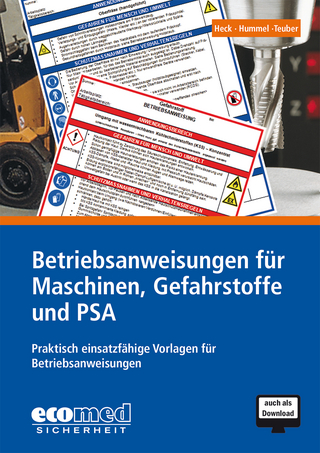
Design of Experiments in Chemical Engineering – A Practical Guide
Wiley-VCH Verlag GmbH (Hersteller)
978-3-527-60416-6 (ISBN)
- Keine Verlagsinformationen verfügbar
- Artikel merken
While existing books related to DOE are focused either on process or mixture factors or analyze specific tools from DOE science, this text is structured both horizontally and vertically, covering the three most common objectives of any experimental research: screening designs mathematical modeling, and optimization. Written in a simple and lively manner and backed by current chemical product studies from all around the world, the book elucidates basic concepts of statistical methods, experiment design and optimization techniques as applied to chemistry and chemical engineering. Throughout, the focus is on unifying the theory and methodology of optimization with well-known statistical and experimental methods. The author draws on his own experience in research and development, resulting in a work that will assist students, scientists, and engineers in using the concepts covered here in seeking optimum conditions for a chemical system or process. With 441 tables, 250 diagrams, as well as 200 examples drawn from current chemical product studies, this is an invaluable and convenient source of information for all those involved in process optimization.
Zivorad R. Lazic is Quality Assurance Manager at Lenzing Fibers Corporation, Lowland, Tennessee, USA. Born in Ljubovija, Serbia, he completed his studies at Belgrade University, writing his thesis under the supervision of Prof. Dragoljub Vukovic. He began his career in Belgrade at the Military Technical Institute (VTI), where he was Head of Department for R&D into composite rocket propellants. He was trained at Hercules Inc., McGregor, TX, and spent more than six years as Vice President for Process and Product Development in P.T. South Pacific Viscose, Indonesia from 1994 until 2001. Dr. Lazic s interests include advanced statistical tools, DOE, SPC, EVOP, neural network modeling and the six sigma approach.
Preface. I Introduction to Statistics for Engineers. 1.1 The Simplest Discrete and Continuous Distributions. 1.1.1 Discrete Distributions. 1.1.2 Continuous Distribution. 1.1.3 Normal Distributions. 1.2 Statistical Inference. 1.2.1 Statistical Hypotheses. 1.3 Statistical Estimation. 1.3.1 Point Estimates. 1.3.2 Interval Estimates. 1.3.3 Control Charts. 1.3.4 Control of Type II error b. 1.3.5 Sequential Tests. 1.4 Tests and Estimates on Statistical Variance. 1.5 Analysis of Variance. 1.6 Regression analysis . 1.6.1 Simple Linear Regression. 1.6.2 Multiple Regression. 1.6.3 Polynomial Regression. 1.6.4 Nonlinear Regression. 1.7 Correlation Analysis. 1.7.1 Correlation in Linear Regression. 1.7.2 Correlation in Multiple Linear Regression. II Design and Analysis of Experiments. 2.0 Introduction to Design of Experiments (DOE). 2.1 Preliminary Examination of Subject of Research. 2.1.1 Defining Research Problem. 2.1.2 Selection of the Responses. 2.1.3 Selection of Factors, Levels and Basic Level. 2.1.4 Measuring Errors of Factors and Responses. 2.2 Screening Experiments. 2.2.1 Preliminary Ranking of the Factors. 2.2.2 Active Screening Experiment Method of Random Balance. 2.2.3 Active Screening Experiment Plackett Burman Designs. 2.2.3 Completely Randomized Block Design. 2.2.4 Latin Squares. 2.2.5 Graeco Latin Square. 2.2.6 Youdens Squares. 2.3 Basic Experiment Mathematical Modeling. 2.3.1 Full Factorial Experiments and Fractional Factorial Experiments. 2.3.2 Second order Rotatable Design (Box Wilson Design). 2.3.3 Orthogonal Second order Design (Box Benken Design). 2.3.4 D optimality, Bk designs and Hartleys Second order Designs. 2.3.5 Conclusion after Obtaining Second order Model. 2.4 Statistical Analysis. 2.4.1 Determination of Experimental Error. 2.4.2 Significance of the Regression Coefficients. 2.4.3 Lack of Fit of Regression Models. 2.5 Experimental Optimization of Research Subject. 2.5.1 Problem of Optimization. 2.5.2 Gradient Optimization Methods. 2.5.3 Nongradient Methods of Optimization. 2.5.4 Simplex Sum Rotatable Design. 2.6 Canonical Analysis of the Response surface. 2.7 Examples of Complex Optimizations. III Mixture Design Composition Property . 3.1 Screening Design Composition Property . 3.1.1 Simplex Lattice Screening Designs. 3.1.2 Extreme Vertices Screening Designs. 3.2 Simplex Lattice Design. 3.3 Scheffe Simplex Lattice Design. 3.4 Simplex Centroid Design. 3.5 Extreme Vertices Designs. 3.6 D optimal Designs. 3.7 Draper Lawrence Design. 3.8 Factorial Experiments with Mixture. 3.9 Full Factorial Combined with Mixture Design Crossed Design. Appendix. A.1 Answers to Selected Problems. A.2 Tables of Statistical Functions. Index.
| Erscheint lt. Verlag | 12.7.2005 |
|---|---|
| Verlagsort | Weinheim |
| Sprache | englisch |
| Gewicht | 10 g |
| Themenwelt | Naturwissenschaften ► Chemie ► Technische Chemie |
| Technik | |
| ISBN-10 | 3-527-60416-2 / 3527604162 |
| ISBN-13 | 978-3-527-60416-6 / 9783527604166 |
| Zustand | Neuware |
| Haben Sie eine Frage zum Produkt? |
aus dem Bereich
